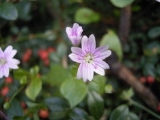
Portulacaceae
Encyclopedia
Portulacaceae are a family
of flowering plants, comprising about 20 genera with about 500 species, ranging from herbaceous
plants to shrub
s. The family has been recognised by most taxonomists, and is also known as the purslane family; it has a cosmopolitan distribution
, with the highest diversity in semi-arid regions of the Southern Hemisphere
in Africa
, Australia
, and South America
, but with a few species also extending north into Arctic
regions. The family is very similar to the Caryophyllaceae
differing in the calyx which has only two sepals.
The APG II system
(2003; unchanged from the APG system
of 1998) assigns it to the order Caryophyllales
in the clade core eudicots. In the APG III system
several genera were moved to the Montiaceae
.
Selected genera
Family (biology)
In biological classification, family is* a taxonomic rank. Other well-known ranks are life, domain, kingdom, phylum, class, order, genus, and species, with family fitting between order and genus. As for the other well-known ranks, there is the option of an immediately lower rank, indicated by the...
of flowering plants, comprising about 20 genera with about 500 species, ranging from herbaceous
Herbaceous
A herbaceous plant is a plant that has leaves and stems that die down at the end of the growing season to the soil level. They have no persistent woody stem above ground...
plants to shrub
Shrub
A shrub or bush is distinguished from a tree by its multiple stems and shorter height, usually under 5–6 m tall. A large number of plants may become either shrubs or trees, depending on the growing conditions they experience...
s. The family has been recognised by most taxonomists, and is also known as the purslane family; it has a cosmopolitan distribution
Cosmopolitan distribution
In biogeography, a taxon is said to have a cosmopolitan distribution if its range extends across all or most of the world in appropriate habitats. For instance, the killer whale has a cosmopolitan distribution, extending over most of the world's oceans. Other examples include humans, the lichen...
, with the highest diversity in semi-arid regions of the Southern Hemisphere
Southern Hemisphere
The Southern Hemisphere is the part of Earth that lies south of the equator. The word hemisphere literally means 'half ball' or "half sphere"...
in Africa
Africa
Africa is the world's second largest and second most populous continent, after Asia. At about 30.2 million km² including adjacent islands, it covers 6% of the Earth's total surface area and 20.4% of the total land area...
, Australia
Australia
Australia , officially the Commonwealth of Australia, is a country in the Southern Hemisphere comprising the mainland of the Australian continent, the island of Tasmania, and numerous smaller islands in the Indian and Pacific Oceans. It is the world's sixth-largest country by total area...
, and South America
South America
South America is a continent situated in the Western Hemisphere, mostly in the Southern Hemisphere, with a relatively small portion in the Northern Hemisphere. The continent is also considered a subcontinent of the Americas. It is bordered on the west by the Pacific Ocean and on the north and east...
, but with a few species also extending north into Arctic
Arctic
The Arctic is a region located at the northern-most part of the Earth. The Arctic consists of the Arctic Ocean and parts of Canada, Russia, Greenland, the United States, Norway, Sweden, Finland, and Iceland. The Arctic region consists of a vast, ice-covered ocean, surrounded by treeless permafrost...
regions. The family is very similar to the Caryophyllaceae
Caryophyllaceae
The Caryophyllaceae, commonly called the pink family or carnation family, is a family of flowering plants. It is included in the dicotyledon order Caryophyllales in the APG III system, alongside 33 other families, including Amaranthaceae, Cactaceae and Polygonaceae...
differing in the calyx which has only two sepals.
The APG II system
APG II system
The APG II system of plant classification is the second, now obsolete, version of a modern, mostly molecular-based, system of plant taxonomy that was published in April 2003 by the Angiosperm Phylogeny Group. It was a revision of the first APG system, published in 1998, and was superseded in 2009...
(2003; unchanged from the APG system
APG system
The APG system of plant classification is the first, now obsolete, version of a modern, mostly molecular-based, system of plant taxonomy that was published in 1998 by the Angiosperm Phylogeny Group. It was superseded in 2003 by a revision, the APG II system, and then in 2009 by a further...
of 1998) assigns it to the order Caryophyllales
Caryophyllales
Caryophyllales is an order of flowering plants that includes the cacti, carnations, amaranths, ice plants, and many carnivorous plants. Many members are succulent, having fleshy stems or leaves.-Description:...
in the clade core eudicots. In the APG III system
APG III system
The APG III system of flowering plant classification is the third version of a modern, mostly molecular-based, system of plant taxonomy...
several genera were moved to the Montiaceae
Montiaceae
Montiaceae is a family of flowering plants, comprising about 14 genera with some 500 species, ranging from herbaceous plants to shrubs. The family has a cosmopolitan distribution....
.
Selected genera
- PortulacaPortulacaPortulaca is the type genus of the flowering plant family Portulacaceae, comprising about 40-100 species found in the tropics and warm temperate regions. They are also sometimes known as Rose Moss or more commonly Moss Roses....
- PortulacariaPortulacariaPortulacaria is a plant genus.Species include:*Portulacaria afra Jacq.*Portulacaria armiana E. J. Van Jaarsveld*Portulacaria namaquensis Sond.*Portulacaria pygmaea Pillans...
- Spraguea
- Talinopsis
- TalinumTalinumTalinum is a genus of herbaceous succulent plants in the family Talinaceae whose common names include fameflower and flameflower. Several species bear edible leaves, and Talinum fruticosum is widely grown in tropical regions as a leaf vegetable...

